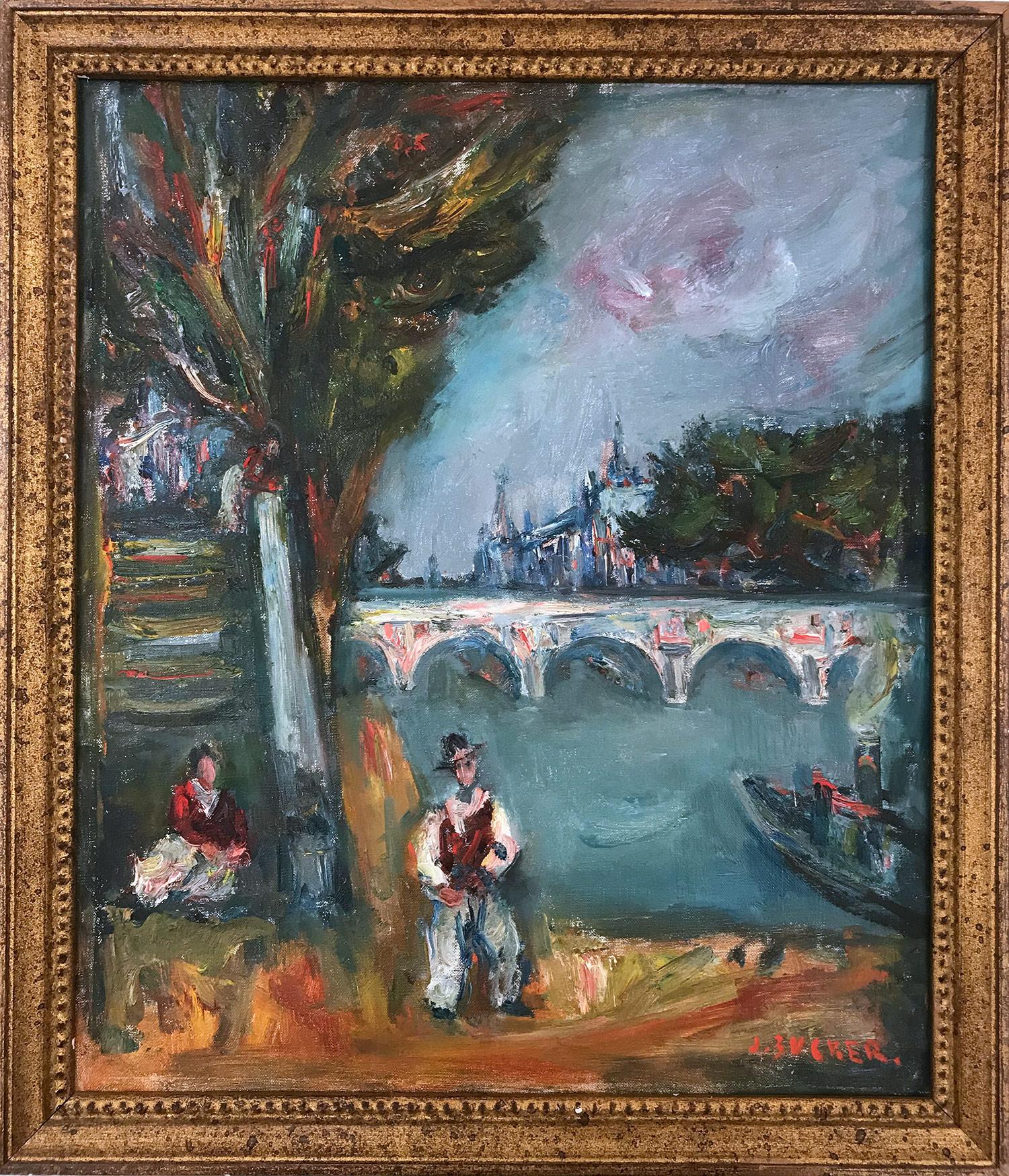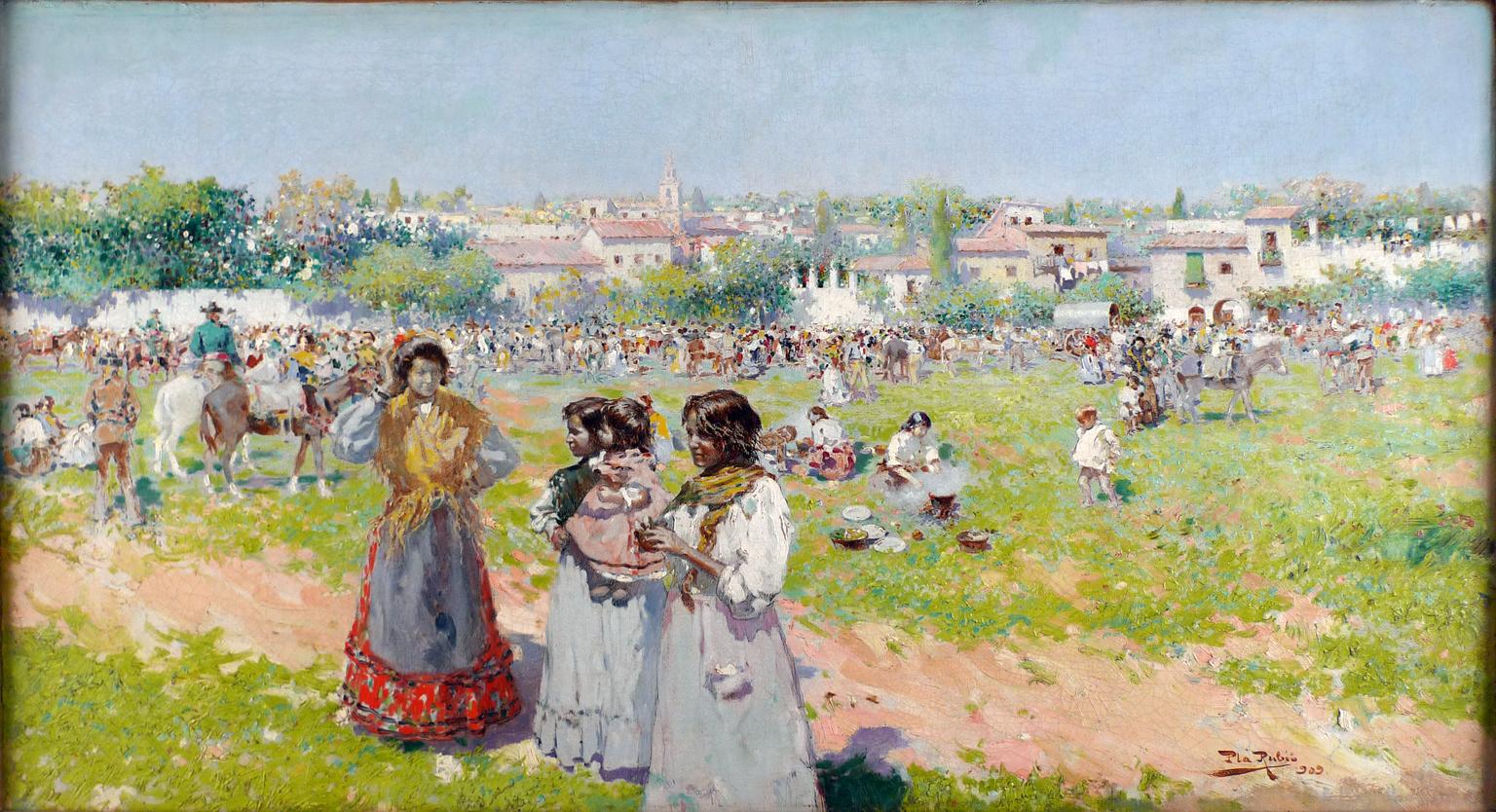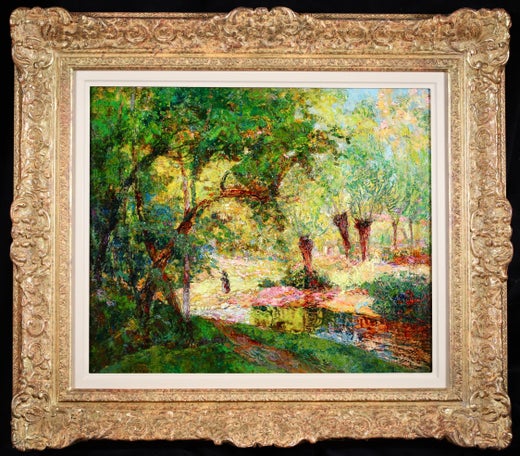Victor CharretonChurch Gardens - French Post Impressionist Oil, Landscape by Victor Charretonc.1910
c.1910
About the Item
- Creator:Victor Charreton (1864-1937, French)
- Creation Year:c.1910
- Dimensions:Height: 26 in (66.04 cm)Width: 31 in (78.74 cm)
- Medium:
- Movement & Style:
- Period:
- Condition:Very good condition.
- Gallery Location:Marlow, GB
- Reference Number:
Victor Charreton
Victor Charreton was the son of a surveyor. He spent his childhood in Chaumont and went to school in Bourgoin. In 1885 he began studying law at Grenoble University and in 1892 became a solicitor at the Lyons Court of Appeal. He had been creating paintings since childhood and was given advice by Ernest Hareux (he did not merely read his treatise on painting, which was highly regarded at the time) and also later by Louis Japy.
In 1902 Charreton gave up his legal career to devote his time to painting. The same year he moved to Paris. Every summer, from 1912 onwards, he would spend time at his house in St-Amant-Tallende near Clermont-Ferrand, where his wife came from. He also traveled abroad — to Algeria in 1905, to Spain and England in 1912 and to Belgium and Holland in 1913 — visiting numerous museums along the way. He also visited Corsica and Germany. He led the life of an aesthete and man of culture and was a lover of poetry and music. In 1914 he was made a Chevalier of the Légion d'Honneur.
Charreton was a landscape artist in the Lyons tradition with a love of sensual impasto. In his works he sought to capture fleeting, momentary effects, like those achieved by the Impressionists: effects at different times of day and in different seasons, such as dusk and snow. As a young man he painted the environs of Bourgoin, but his marriage in 1893 took him to Auvergne where he painted the characteristic landscapes of the region. Landscapes of Auvergne make up approximately two-thirds of Charreton’s output. What became known as the School of Murols, named after a village in Auvergne, was principally formed around him between 1910 and 1925. Skilled in capturing minute changes in the weather, he was also adept at capturing the spirit of new places.
Beside his native Dauphiné and his adopted Auvergne, Charreton was also charmed by the landscapes of the Île-de-France and Paris — Montmartre, the Jardin du Luxembourg and the Parc Montsouris — and also Provence, Creuse and Brittany. However, no trace has been found of his trips abroad. It would be a misjudgment to think that Charreton only painted pretty picture-postcard scenes in the regions he visited; on the contrary, he would seek out the intimist qualities of a place, choosing perhaps a quiet hamlet, with a humble bridge over an anonymous stretch of water, or an ordinary tree outside a tumbledown house.
Charreton would paint blazing autumn landscapes, with a sumptuous color palette, but also favored snowy scenes, their exact chromatic opposite. At the start of his career he would paint dusky scenes and contre-jours in halftones and misty sunsets. As Charreton’s artistic development progressed, he attached more and more importance to light and color. In this respect his work follows on from that of Ravier and, like Guillaumin, it is almost a precursor to Fauvism, or alternatively can be regarded as complicit with it, like the work of Maurice Marinot. Charreton’s brushwork evolved in tandem with his use of color, which became ever more vibrant; for example his fondness for purple hues and later his striking color contrasts. His brushwork became more conspicuous and he would suppress the insignificant details in order to bring out the forms that made up the general composition.
Among art historians Charreton is not ranked alongside the innovators who succeeded the Impressionists, like Gauguin, Seurat, Van Gogh or Cézanne. Older than Matisse, who was himself already by far the eldest of the Fauves, Charreton stopped short of what he considered to be their excesses. He placed himself at the crossroads between two centuries: the end of the century of Impressionism and the start of the leaps made by Fauvism. His life and the major themes in his work are evidence of this, but he decided to be a regional painter; as such, his talent and qualities are clearer than they may otherwise have been if he had chosen a more ambitious career. Beside his painting, he also wrote a play in three acts entitled The Montrouge Well (Le Puits de Montrouge), which was performed in Bourgoin in December 1883.
Charreton made his debut at the Lyons Salon in 1894 with Morning in Montpeyroux. That same year he began exhibiting in Paris at the Salon of the Société des Artistes Français, showing October Evening. He was awarded an honorable mention in 1910, a silver medal in 1912, a gold medal in 1913 and a commendation outside the competition in 1914. He also became a member of the committee and the jury and exhibited there until his death.
Charreton took part in collective exhibitions in France — in Toulouse, Clermont-Ferrand, Roubaix and Bordeaux — and abroad, in New York, Geneva and Barcelona. In 1915 he held a solo exhibition at the Galerie Georges Petit in Paris. He exhibited in New York, Toledo, Pittsburgh, Cleveland and Japan. In 1931 Charreton inaugurated the Musée de Bourgoin by donating around 20 works; the museum then changed its name to the Musée Victor Charreton. He was also one of the founders and general secretary of the Salon d'Automne. In 1972 the Musée de Montmartre organized a posthumous retrospective exhibition of his work; in 1987 and 1989 two more were held in a Paris gallery; then in 2003 the Musée de Bourgoin-Jallieu (in Isère) held in exhibition entitled “Victor Charreton: The Public Collections.”
Find original Victor Charreton art on 1stDibs.
(Biography provided by Leighton Fine Art)
- ShippingRetrieving quote...Ships From: Marlow, United Kingdom
- Return PolicyA return for this item may be initiated within 3 days of delivery.
- La Porte Saint Denis, Paris - Post Impressionist Cityscape Oil by Lucien GeninBy Lucien GéninLocated in Marlow, BuckinghamshireSigned oil on original canvas figures in landscape circa 1930 by French post impressionist painter Lucien Genin. The work is centred around the Porte Saint-Denis - a triumphal arch located in Paris, France. The street is bustling with city-goers and cars pass by the tall buildings painted in red, yellow and white. Signature: Signed lower left Dimensions: Framed: 27"x31" Unframed: 20"x24" Provenance: Private French collection Lucien Génin came from a family of stone-cutters. He first studied at the art school in Rouen, then in 1919 entered the École des Arts Décoratifs in Paris. He settled in Montmartre early in the 1920s, and in 1936 moved to the Latin Quarter. Although he had received a thorough training, he created his own completely spontaneous technique aiming at approaching his subjects with a fresh look. Beside a few views of Rouen, Lorient, Dinan and Villefranche-sur-Mer, Génin specialised in the popular theme of views of Paris. He worked swiftly, making rapid jottings, and thus could produce many paintings. At auction his pictures were sometimes sold in lots. He painted both in oils and in gouache. Lucien Génin showed work at the Salon d'Automne in 1926 and 1930. His work featured at the Marcel Aymé and the Painters exhibition, Galerie Roussard...Category
1930s Post-Impressionist Landscape Paintings
MaterialsOil, Canvas
- Le Moulin de la Folie a Crozant - Impressionist Landscape Oil by Paul MadelineBy Paul MadelineLocated in Marlow, BuckinghamshireSigned and dated oil on original canvas by French post impressionist painter Paul Madeline. This beautiful work depicts a mill on the bank of a river - water cascading over the rocks...Category
Early 1900s Post-Impressionist Landscape Paintings
MaterialsCanvas, Oil
- Venice - Post Impressionist Venetian Landscape Oil Painting by Leon DetroyBy Leon DetroyLocated in Marlow, BuckinghamshireSigned landscape oil on canvas circa 1910 by French post impressionist painter Leon Detroy. This work is painted in a divisionist style and depicts a view of gondolas on the canal in...Category
Early 20th Century Post-Impressionist Landscape Paintings
MaterialsCanvas, Oil
- Boats in the harbour - Menton - Post Impressionist Landscape Oil by Leon DetroyBy Leon DetroyLocated in Marlow, BuckinghamshireSigned landscape oil on canvas circa 1900 by French post impressionist painter Leon Detroy. This work is painted in a divisionist style and depicts a view of sailing boats moored in ...Category
Early 1900s Post-Impressionist Landscape Paintings
MaterialsCanvas, Oil
- L'estacade du quai de Southampton - Post Impressionist Landscape Oil - Jean DufyBy Jean DufyLocated in Marlow, BuckinghamshireSigned and dated post impressionist riverscape oil on canvas by French painter Jean Dufy. The piece depicts a view of a steam boat sailing on the estuary of the River Seine in Le Hav...Category
1920s Post-Impressionist Landscape Paintings
MaterialsOil, Canvas
- The Harvesters - Post Impressionist Figures in Landscape Oil by Charles FrechonLocated in Marlow, BuckinghamshireSigned figures in landscape oil on canvas by French post impressionist painter Charles Frechon. The work depicts two woman harvesting a field on a sunny summer's day. One woman is resting against a hay bale. Signature: Signed lower left Dimensions: Framed: 27"x31" Unframed: 20"x24" Provenance: Private collection - Rouen Charles Fréchon joined the Académie de Peinture et de Dessin in Rouen in 1879 and met Joseph Delattre and Charles Angrand. He then went to Paris and in 1881 enrolled at the Académie Colarossi. When he returned to Rouen he painted mainly from life.Fréchon painted landscapes in an Impressionist style and was one of the instigators of the so-called School of Rouen. The School took its name from the fact that painters such as Joseph Delattre, Léon Jules Lemaître...Category
Early 1900s Post-Impressionist Landscape Paintings
MaterialsOil, Canvas
- "Parisian Scene by Pont Neuf with Notre Dam" French Impressionist Oil PaintingBy Jacques ZuckerLocated in New York, NYThis painting depicts a landscape scene of a Parisian Scene by Pont Neuf with Notre Dam in the distance behind the bridge. The attractive perspective is what makes this painting so i...Category
20th Century Post-Impressionist Landscape Paintings
MaterialsOil, Canvas
- Place de la République, 20th Century Oil on Canvas by Edouard Léon CortèsBy Édouard Leon CortèsLocated in Madrid, ESEDOUARD LÉON CORTÈS French, 1882 - 1969 PLACE DE LA RÉPUBLIQUE signed "EDOUARD CORTÈS." (lower right) oil on canvas 25-3/4 x 36-1/4 inches (65 x 91.5 cm.) framed: 33-1/2 x 44-1/4 inc...Category
1930s Post-Impressionist Figurative Paintings
MaterialsOil, Canvas
- "At the Annual Fair", an early 20th Century oil on canvas by Alberto Plá RubioLocated in Madrid, ESALBERTO PLA Y RUBIO Spanish, 1867 - 1937 AT THE ANNUAL FAIR signed & dated "Pla Rubio, 909" (lower right) oil on canvas 14 X 25-5/8 inches (35.5 X 65 cm.) ...Category
Early 1900s Post-Impressionist Landscape Paintings
MaterialsCanvas, Oil
- Henri-André Martin Road in Eygalieres, Alpilles, Provence, Oil on Canvas, 1999By Henri-André MartinLocated in Saint Amans des cots, FROil on canvas by Henri-André Martin (1918-2004), France, 1999. Road in Eygalieres, Alpilles, Provence. With frame: 52x67 cm - 20.5x26.4 inches. Without frame: 46x61cm - 18.1x24 inches. Format 12P. Signed and dated lower left "Henri-André Martin 99" (see photo). Located on the back (see photo). Can be matched to make a pair with another painting by Henri-André Martin that we offer on 1stdibs whose title is "Henri-André Martin Road in the Alpilles, Provence, Oil on Canvas, 1980s". Born in Lyon in 1918, the child and the adolescent Henri-André Martin spent his youth in Saint-Étienne, his father, Edme Martin, first installed as a practicing doctor in Lyon, having been appointed doctor of the anti-tuberculosis dispensaries of the Loire. During his first years of studying medicine in Lyon, he nevertheless enrolled in the Beaux-Arts. Appointed hospital intern upon his return from captivity in 1942, he ended his medical career as director of the otolaryngology university clinic at Édouard-Herriot hospital. But painting was his passion. Painting was for Henri-André Martin the way of expressing his feelings. By nature very reserved and of an extreme modesty that many took for coldness, it was what allowed him to express his strong artistic sensitivity and, his pictorial periods are as many reflects of his anxieties, of his hopes, of his joys. At every period of his life, wherever he goes and whenever he has a moment, he paints gouaches, often of small size, but sometimes of larger size. He also paints beaches that have been compared to those of Boudin. Their invoice shows, however, that this figure is only appearance and that in fact, these beaches made of water, sky and sand, readily dispense with the motif, the work of the material seeming to have more importance. as the subject. Despite the fact that until the 1970s he painted "on the ground", his canvases remain far removed from the anecdote. Often harsh like the landscapes of Provence, the Parisian walls which express concern, or the railways, the switch tracks which suggest, in ocher and black, all the embarrassment of choice. We find the same nostalgic gravity in the canvases of the carcasses of boats which, as his friend Louis Pons later wrote, "seem to die of immobility" or in the canvases of Venice, or the landscapes of Eygalières. In the following years, his painting became simpler, more synthetic, such as these landscapes with tortured almond trees, black and gnarled olive trees, plane trees standing out against the ocher sky of the dawn of Provence, in winter. These are also the canvases of Hamburg in the dough becomes heavier, the colors darken, marking all the gravity of the port landscapes. Workshop work gradually takes precedence over motif painting. The pivotal period coincides with that of his work on the olive tree, during which he leads the realization of the "Trunks", a collection of six lithographic plates, of the book L'olivier comprising many lithographs and serigraphs, but also texts. poetic and numerous paintings. He then became passionate about everything related to the olive tree (literature, painting, traditions, history), but also to the tree itself, its thousand-year-old history, its poetry, its symbols, but also its culture, its size. oil production...Category
1990s Post-Impressionist Figurative Paintings
MaterialsCanvas, Oil
- Oil on Canvas by Jallais, Boats in Port, 1960sLocated in Saint Amans des cots, FROil on canvas by Jallais, France, 1960s. Boats in port. In its pretty dark brown wooden frame. With frame: 68x58 cm - 26.8x22.8 inches, without frame: 61x50 cm - 24x19.7 inches. 12F ...Category
1960s Post-Impressionist Figurative Paintings
MaterialsCanvas, Oil
- Bords du Loing by Alfred Sisley - Oil, landscape paintingBy Alfred SisleyLocated in London, GB*THIS PRICE INCLUDES 5% IMPORT DUTY APPLICABLE IF THE WORK REMAINS IN THE UK ONLY. Bords du Loing by Alfred Sisley (1839-1899) Oil on canvas 46.1 x 55.7 cm (18¹/₈ x 21⁷/₈ inches) S...Category
1890s Post-Impressionist Landscape Paintings
MaterialsCanvas, Oil




